A staircase is not only a means of communication between different floors, but also an element of the interior that has a direct impact on the appearance of the room. Most of the visual impression is created by the chosen structure of the staircase - it can be modular, on bowstrings, on stringers, etc. depending on the general style of the room.
When choosing components for a future structure, it is worth considering that the lion's share of attention is captured by the design of the stair railings, through which the frame for the staircase is created. This is the most noticeable element, the appearance of which is striking in the first place - with its help, you can both enhance the created image, and vice versa, completely cross it out.

There are several types of railings on the stairs - the variety of these products can satisfy even the most demanding taste. However, a large selection of stair handrails implies not only great opportunities, but also a certain risk. Our article will allow you to familiarize yourself with the intricacies of choosing this product and decide on one of the options.
Views
Solid railings
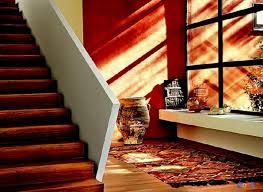
This structure is a solid fence, which until recently was created exclusively from heavy building materials - facing bricks or concrete slabs.
However, today you can often find solid stair handrails and railings made of:
- wood,
- drywall,
- metal,
- tempered glass, etc.
Their main difference is the absence of any holes or slots in the structure.
When installing solid parapets, a prerequisite is the presence of a handrail, the section of which should not be less than the thickness of the fence - this is a necessary element of design and functionality. The handrails do not have to be made of the same material as the handrails themselves - the emphasis in this case is on compliance with the overall design line.
The posts for solid railings do not play almost any role and serve only as a decorative function. They are not load-bearing and can be used as an intermediate element to connect two planes or not be used at all.
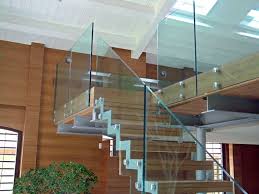
Giving preference to this type of railing, you should pay attention to the fact that if heavy building materials are used as the material for the fence, then massive stairs should serve as the basis for their placement - ready-made staircases made of concrete, or stairs lined with brick or natural stone ...
This condition is mandatory due to their high weight. This circumstance does not apply to lightweight analogues.
Handrail with ornament
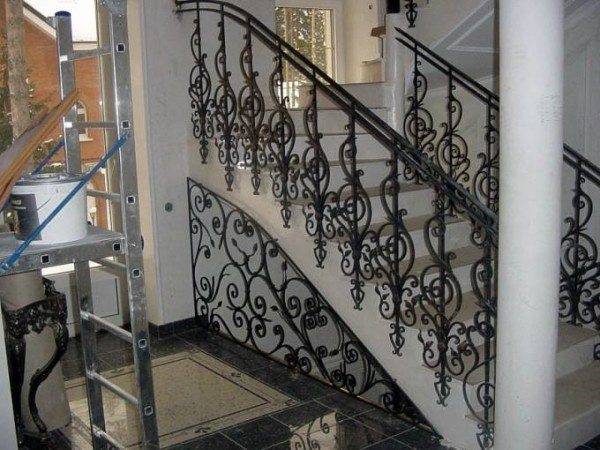
This type of handrail is the most perfect from a visual point of view, as it contains various cutouts and through holes in the form of an ornament or curly ligature in its design. This is the most artistic decoration of the staircase - these products are often a real work of art. Most often wood or metal is used as the main material for their manufacture.
Ornamental handrails are produced in specialized workshops in the form of separate sections. Self-made or handicraft production is not possible, as this will completely negate the created effect of nobility and grace.
Structural elements, namely:
- drawing,
- material,
- sizes, etc.
have a wide selection that can satisfy even the most sophisticated taste.
In addition to wood or metal, stucco molding, bas-reliefs, high-reliefs and stained-glass windows can be used as a material for the manufacture of sections. All of the above names can be combined in various combinations depending on your imagination.
Ornamental fences can be both massive and heavy, and gracefully weightless - their only serious drawback is the rather high price compared to other analogues.
Railing with balusters
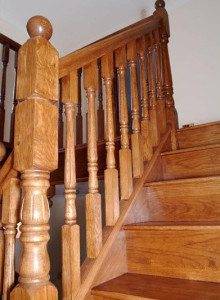
This is the most traditional type of stair railings, which consist of balusters - support pillars on which the handrails rest. The appearance of the fence has a through lattice structure - this is the simplest and most optimal combination of elegance and functionality.
The appearance of stair rails with balusters depends on the design of the staircase - their structure is flexible enough, which allows you to create with their help both straight and rounded structures.
Wooden balusters are often decorated with patterned carvings - the use of ordinary timber is quite rare. Iron bars can also be crafted through artistic forging or have a strict classic look, depending on the overall style of the staircase.
Railings with balusters, unlike previous counterparts, can be easily installed with your own hands - below you will be provided with step-by-step instructions for their own installation.
Note! This article will provide guidance on the installation of wooden products, since the process of installing metal, glass or other elements completely depends on the specifics of their design - their installation can only be carried out following the instructions from the manufacturer.
Handrail installation

Initially, it is necessary to order the railings in the carpentry workshop - it is not possible to make them at home without the proper skills and the necessary equipment. However, by assembling the finished handrail yourself, you can reduce your total cost of 30%.
- The main bearing pedestals are being installed, which are the starting and finishing elements of the staircase. Supporting pillars can also be located in the place of sharp turns, in which they act as a connecting element. When installing them, it should be borne in mind that the height of the handrail should be in the region of 80-90 cm and, accordingly, the places of its fixation should be at the proper level;
- A guide thread is drawn between the posts, which will indicate the location of the handrail. It also determines the line along which the balusters will be placed - for this, small nails are hammered in the lower part of the guide post, onto which the thread is then pulled;
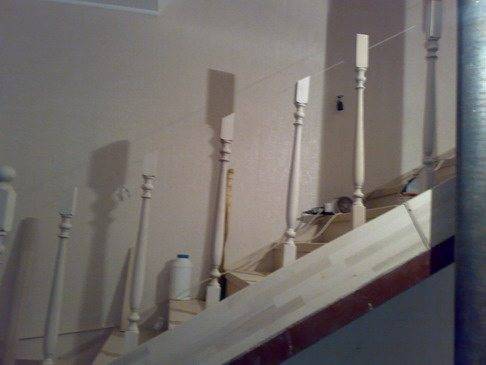
- The handrail is attached to the ladder on bowstrings or directly on the steps, depending on the design of the ladder. However, it should be noted that fastening to the bowstrings will be a more reliable option;
Note! In both cases, the balusters must be placed strictly vertically (at an angle of 90 degrees). This circumstance is determined visually or by means of a building level.
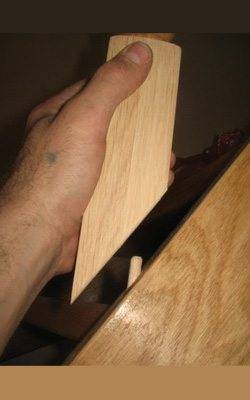
- The marking of the places where the balusters will be located is carried out - the distance between the railing of the stairs should not exceed 20 cm. This will exclude the likelihood of small children falling. If the fastening will be carried out on the steps, then the balusters are mounted "as is", if on the bowstrings, then the lower edge must be filed at an angle in accordance with their slope;
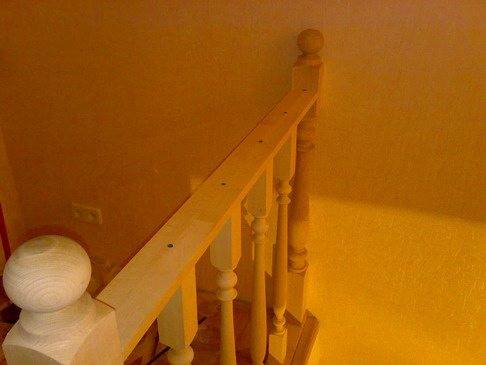
- Direct fixation of the railing is carried out by means of self-tapping screws or spikes mounted into the end of the balusters, which are planted on the glue solution, thereby eliminating the possibility of loosening and squeaking. After their installation, the handrail is installed;
Outcome
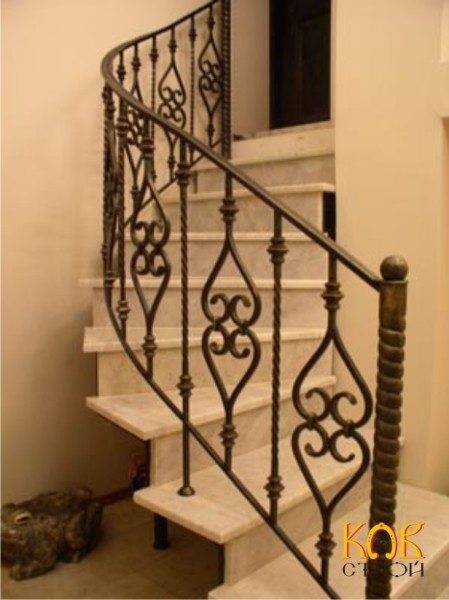
Stair railings are a prerequisite for the safety and convenience of the stairs, with their help you can supplement or completely transform the appearance of the staircase. The video in this article will tell you a little more, let's watch!


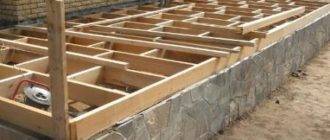




I pondered for a long time which ladder to install and still decided that it was wooden, it was more homemade or something. The material was chosen by pine, for me the budget price tag, we have 300 rubles per step in the merlin. bought a yacht varnish, as the most wear-resistant. After talking with experts, I decided to do it myself.